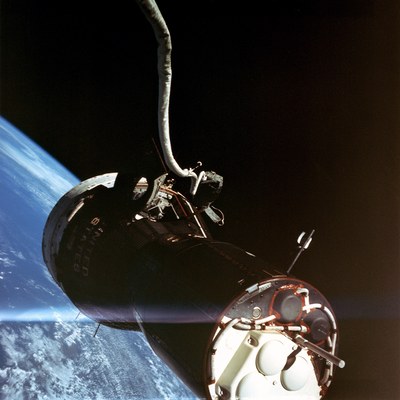Riding Titans (part 2)by Dwayne A. Day
|
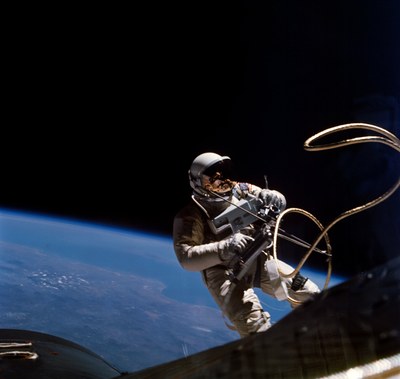 Ed White during his historic first spacewalk. (credit: NASA) |
The radar engineer
Ralph Strong, a Westinghouse project manager, started the afternoon session with an explanation of what Westinghouse was. Today the company is virtually unknown, but in the 1950s it was a household name, responsible for everything from nuclear reactors in submarines to kitchen appliances. The company was also a leader in radar systems, which is why it was selected to develop the rendezvous radar for the Gemini.
Strong explained that when they got the Gemini contract, Westinghouse had already been working on a space radar for the SAtellite INspecTion system, or SAINT, which was designed to intercept and photograph Soviet satellites. Westinghouse built five SAINT radars and although he did not know for sure, he thought that the United States ultimately launched one of them in secret. (I do not believe this is correct.)
| The radar problems demonstrated an axiom that Strong believed in: “random failure is one which you are unwilling to spend the energy to understand.” |
After describing the radar system components, Strong explained that they had no failures until Gemini 12, when the radar suddenly failed after completing the rendezvous with the Agena target vehicle. Strong said that the designers had assumed that it is impossible for electromagnetic arcing to occur in hard vacuum. This was not true, and what they discovered was that free electrons can start to bounce back and forth between two plates, eventually leading to an arc and a short. When the engineers went back and looked at data from previous missions they discovered that the same problem had occurred on all of them as well, but it had occurred sufficiently after the rendezvous that nobody had noticed it. It demonstrated an axiom that Strong believed in: “random failure is one which you are unwilling to spend the energy to understand.”
The radar was mounted at the nose of the spacecraft and had to be jettisoned before the parachutes were deployed. Strong said that one radar unit was recovered after reentry and was shipped back to Westinghouse in a barrel of saltwater. It was corroding so rapidly it was boiling. The faceplate of the radar had some radioactive material in it and it was in such bad shape it was quietly scrapped.
This was not the only toxic issue they had to deal with. One design question they were told to address was the possibility of urine from waste dumps getting on the radar connectors. Without going into details, Strong said that they started to investigate it, but determined that there was so much variation in the individuals’ urine chemistry that it was impossible to truly simulate it. That was not the cause of the radar shorts, however.
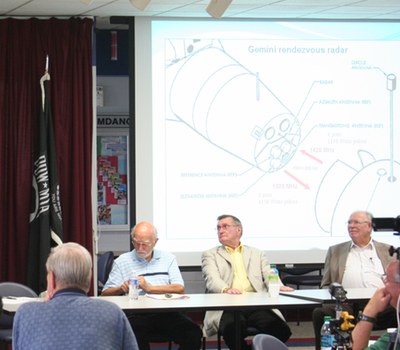 Sam Mattingly, Dick Gordon, and Ralph Strong during the Gemini symposium. Note the Gemini radar drawing on the screen. (credit: D. Day) |
The divers
Sam Mattingly, a Gemini contractor, was the next speaker. He was head of Environmental Research Associates in 1964 when his company got a contract from NASA to evaluate an airlock. He said that at the time nobody really knew how an airlock should be designed, other than its basic purpose. For example, they did not know what shape or how big it needed to be. So his company built a clear plastic mockup of a NASA airlock design and submerged it in the swimming pool of the private McDonogh School outside Baltimore. He then borrowed a pressure suit, received some rudimentary training in how to use it, and then went into the pool. What they discovered was that the diameter of the initial airlock design was too small: an astronaut could go through the hatch, but could not turn around to close the hatch behind him.
Their initial experiments demonstrated how important it was to test the designs with humans. They discovered that some parts were too close together and others not close enough. For example, they started working on the Apollo Wet Workshop, an early concept of what eventually became Skylab. The Wet Workshop concept was that NASA would launch a Saturn S-IVB stage into orbit with fuel inside that would be used up during flight. Astronauts would then connect up to the stage, remove a large hatch, and go into the stage to outfit it for human occupation.
Mattingly’s company constructed a large frame in the shape of the top dome of an S-IVB stage equipped with a bolted hatch, and a large airlock cylinder that would connect to the top of the dome. An astronaut would move through the cylinder and then use a wrench to detach over thirty bolts that held the hatch on. They quickly discovered that the NASA design was unworkable.
| Cernan, in his spacesuit, helmet cocked under his arm like The Right Stuff, walked over to the kids and said hello. They didn’t get to swim that day, but they did get a pep talk from an American hero. |
One day astronaut Scott Carpenter showed up unannounced. According to Mattingly, this was common NASA practice—they would simply show up without warning so that the contractor could not prepare. Carpenter observed a test in the tank where a diver wearing a pressure suit spent a long time removing only three bolts before running out of oxygen. The problem was that there was insufficient room to turn the wrench all the way around. Carpenter was skeptical and insisted on going into the pool himself. So they suited him up and put him in the tank and in the same amount of time Carpenter was able to remove only a single bolt. Mattingly said he has a recording of Carpenter—apparently using salty language—describing the task.
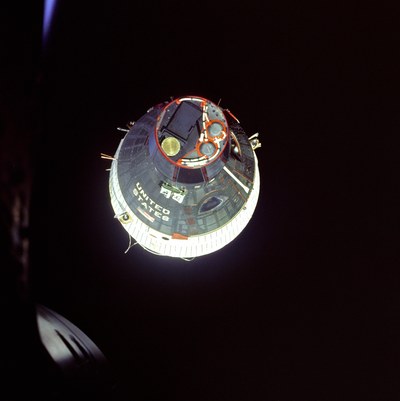 The rendezvous radar was located on the nose of the spacecraft, under the section on the upper left. (credit: NASA) |
For much of the Gemini program Mattingly and his employees worked on spacecraft design and tool development, not training. But after the flight of Gemini 9-A, astronaut Gene Cernan visited the facility—once again unannounced—to look at the work they were doing. Cernan had recently concluded a spaceflight with a spacewalk that had gone very badly. Cernan concluded that if he had been able to practice before his spacewalk, he might have been successful at achieving the goals of his mission, which included strapping on a maneuvering backpack called an Astronaut Maneuvering Unit.
Mattingly’s company shared the swimming pool with the school, which often meant that they worked at night when the kids weren’t swimming. One time when Cernan was there they were running behind schedule when the headmaster informed him that the kids were scheduled for a swim. Mattingly replied that they absolutely needed the pool, so the headmaster asked if the kids could stay and watch. He said yes, and then Cernan, in his spacesuit, helmet cocked under his arm like The Right Stuff, walked over to the kids and said hello. They didn’t get to swim that day, but they did get a pep talk from an American hero.
Cernan went back to Houston and told his bosses that Buzz Aldrin, who was then planning on a spacewalk on Gemini 12, should use the facility for training prior to his flight. Whereas astronauts who returned from space missions had a lot of free time, Mattingly knew that an astronaut preparing for a mission had very little time and he asked NASA to give them warning when Aldrin would show up so that they could maximize his training. NASA had mockups of the Gemini adapter and the experiments and the Advanced Maneuvering Unit flown in from McDonnell in St. Louis so Aldrin could practice on them. Aldrin then used the swimming pool and the techniques they developed and went on to fly a very successful EVA. Throughout his talk, Mattingly showed a number of color photographs of the various tests and training conducted in the school swimming pool.
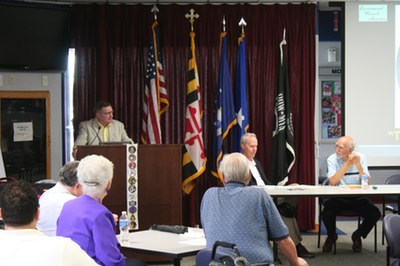 Astronaut Dick Gordon speaking about EVA operations during the Gemini program. (credit: D. Day) |
The spacewalker
Astronaut Dick Gordon was the next speaker. He talked about both the rendezvous tasks that made use of the Westinghouse radar as well as the EVA that he performed on his space mission. He explained that his mission was intended to prove the “direct rendezvous” technique where the Lunar Module would rise straight up to meet the Command Module instead of slowly moving toward the proper orbit. He said that all of the commands and measurements for his mission were performed on the ground, which annoyed his pilot, Pete Conrad, as well as Gordon. They disliked that all of the techniques they had in the spacecraft were referred to as “backup solutions.” He noted that the rendezvous techniques they developed for Gemini were later changed for the shuttle program and the shuttle performed its rendezvous with the International Space Station via different methods.
| “My failures on 11 made Buzz very successful on Gemini 12,” said Gordon. “He’s been living off that ever since.” |
Gordon was impressed with the capabilities of the Apollo spacecraft. He served as the Command Module Pilot on Apollo 12 where his spacecraft had sufficient fuel to go down and rendezvous with a Lunar Module that had failed to reach proper orbit. If the LM was in “clear lunar orbit” which they defined as a 10-mile orbit, the Command Module could reach it. Gordon was slated to become the commander of Apollo 18, but that mission was canceled due to budget cuts.
Gordon recounted how he performed a stand-up EVA during Gemini XI11 He said that EVA is easy if you have nothing to do, it’s only when the astronaut has to actually accomplish something that it becomes difficult. “I hate to even think about it,” he said. He was supposed to travel forward of his spacecraft and reach an object on the Agena, but his first attempt sent him sailing out into space and Conrad had to haul him back. He then realized that he could accomplish his task by straddling the front of the Gemini and leaning forward, but it took a great deal of effort.
“My failures on 11 made Buzz very successful on Gemini 12. He’s been living off that ever since.”
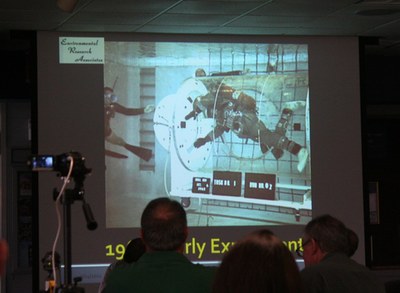 Environmental Research Associates conducted the first underwater simulations of spacewalking in a private school swimming pool outside of Baltimore during 1964–1966. These tests led to training astronauts for EVAs. (credit: D. Day) |
The skywalker
Tom Jones, a veteran of four shuttle missions, talked about how EVA is conducted today. His talk was based upon his own experience in 2001, but he said that since then the ISS spacewalks have led to the development of a lot of new tools.
Jones said that NASA astronauts had learned a lot of lessons about spacewalking starting with Gemini. The big lessons involved the importance of proper foot and leg restraints. He showed photographs of the International Space Station that revealed its surface covered with handholds. The astronauts have various foot restraints that they can plug themselves into. A relatively new development is the “body restraint tether”, or BRT, a flexible “ball-stack” rigidizing tether that clamps onto a handrail while attached to the EMU (spacesuit) left hip. Once stiffened by the crewmember’s rotation of the collar, it can serve as a third arm and hand to stabilize the astronaut. The astronauts fold it over their chest display unit when not in use, to keep it from snagging on things.
Similarly, tools have advanced significantly since the early days of the wrench in the McDonogh School swimming pool. Today they have computer-controlled power tools that can serve multiple functions and even control torque and count the number of rotations to a screw or bolt. These tools tend to be bulky, however.
The astronauts now conduct extensive underwater training, on average six hours underwater for every hour they spend on an EVA. The biggest problem is not so much accomplishing the individual tasks as it is dealing with the muscle fatigue that sets in after hours in space. Forearms and fingers become tired. NASA does have plans to develop better spacesuits, but funding shortfalls have prevented much development in recent years.
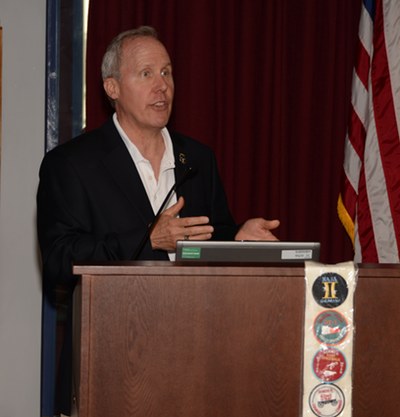 Astronaut Tom Jones discussing EVA operations aboard the International Space Station. (credit: Master Sergeant Ed Bard, MDANG) |
Gemini forever
In his autobiography Gus Grissom praised the Gemini and wrote that he thought it would have a long future. Of course, his only comparison was the Mercury spacecraft. He had not yet flown the Apollo spacecraft, which would eventually kill him. Grissom’s Gemini flight lasted only three orbits. Had he been forced to spend a week or even a few days inside the cramped cockpit he might have had a different perspective.
Gemini served a vital purpose in the American space program, providing operational and engineering experience that enabled the United States to pull ahead in the space race with the Soviet Union. But it was a limited craft without a lot of room for growth. It had no provisions for an airlock, little extra delta-v or maneuvering power, and no computing power.
Gemini was well-made and capable. At the time that the last NASA Gemini flew, the Air Force was planning on buying at least half a dozen more for the Manned Orbiting Laboratory program. The Gemini-B would have served as an ascent and landing spacecraft, a role that it could have performed well had it been given the chance. It is unclear just how many Gemini-B spacecraft McDonnell-Douglas built for the MOL program. Many aspects of MOL were classified, but others were not, and maybe no Gemini-B’s were ever completed. But perhaps sitting in a warehouse somewhere is a couple of unused Gemini spacecraft, still in their plastic wrap.
